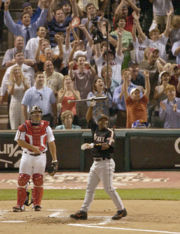
1990s and Now
Latino Dominace in Major League Baseball
Even more so than in the 1970s and 1980s, Latinos occupied a dominant position in Major League Baseball throughout the 1990s and continue to do so today. Though Latinos accounted for less than 10% of the total U.S. population in 1990, Latinos made up 13% of the players in the MLB (20). This number skyrocketed throughout the remainder of the 1990s and into the 2000s, increasing to 24% in 1997 and eventually reaching the point where Latinos held 26% of Major League contracts in 2004 (21). Amazingly, over one-third of the total salaries paid in 2006 to all Major League baseball players were paid to Latino baseball players from the Dominican Republic, Puerto Rico, and Venezuela (22). The 1990s also saw increased recognition of former Latino ball players, as Rod Carew (1991), Tony Perez (1999), and Orlando Cepeda (2000) were all inducted into the National Baseball Hall of Fame during this time period, almost doubling the number of Latinos in the Hall of Fame in the process.
It would be one thing if there were simply a large number of Latino players in Major League Baseball, but in fact these players are often among the best in the game. In 2006 for example, 23 out of 71 All-Stars were Latino and 6 of the 10 players with the highest batting averages were Latino, a stark increase even from 1990, when 9 of the 58 All-Stars were Latino and only one of the top 10 batting averages was held by a Latino player (23). Since 1990, six of the last 15 players to win the Most Valuable Player awards in the All-Star game have been of Latino descent; before these six there had only been three Latino players to win the award since its inception in 1962 (Juan Marichel-1965, Tony Perez-1967, Dave Concepcion-1982) (24).
During the 1990s, over 1/8th of Major League All-Stars were born in Puerto Rico or the Dominican Republic, well above the average for American-born players. Though many Latino countries are represented in the MLB, the vast majority of Latino players hail from the Dominican Republic, Puerto Rico, and Venezuela. Eight different countries had Major League representation in 2000, but 135 of the 170 players were from one of the three aforementioned regions (25). The number of players from the Dominican Republic, Venezuela, and Puerto Rico have only increased since 2004, now reaching 171 players (26).
Another strong indicator of the strength of Latino baseball was evidenced in the World Baseball Classic, which held its inaugural competition in March of 2006. The World Baseball Classic, or WBC, pits 16 countries against each other in a combination of round-robin and bracket tournament style play. Of the 16 teams competing in the WBC early in 2006, six of them were Latino-orienting nations: Venezuela, Dominican Republic, Cuba, Mexico, Puerto Rico, and Panama. Of the six, Panama was the only one failing to advance past the first round of competition, with two of the remaining five, Cuba and the Dominican Republic, advancing to the final four and Cuba going all the way to the finals, only to narrowly lose to Japan.
With the ever-increasing Latino presence in Major League Baseball, the MLB is doing its part to market to an increasingly Latino audience and allow them exposure to the games. Nineteen of the 30 Major League teams within the United States offer radio broadcasts of games in Spanish (27). Additionally, Major League games are available on television in Central America, South America, and the Caribbean through ESPNdeportes, ESPN2, and ESPN+, the Spanish-language sports programming equivalents of ESPN (28).